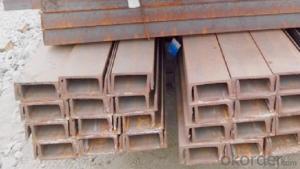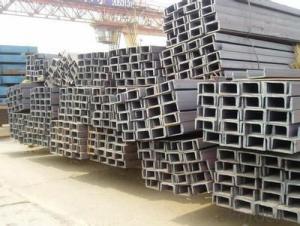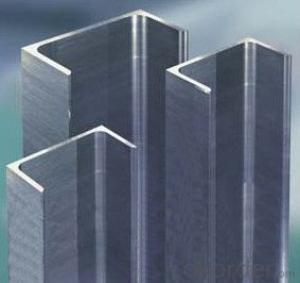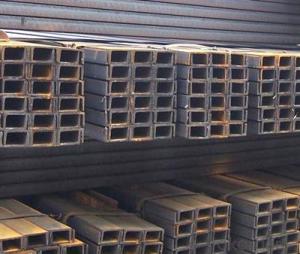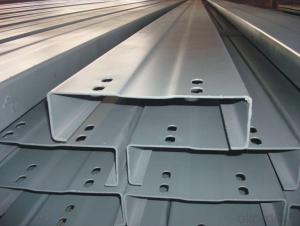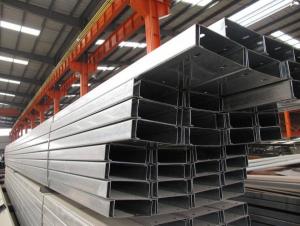Hot Rolled Channel Steel AISI,ASTM,BS,DIN,GB,JIS Standard
- Loading Port:
- Tianjin
- Payment Terms:
- TT OR LC
- Min Order Qty:
- 2000 PCS
- Supply Capability:
- 40000 PCS/month
OKorder Service Pledge
OKorder Financial Service
You Might Also Like
Hot Rolled Channel Steel AISI,ASTM,BS,DIN,GB,JIS Standard Details
| Standard: | AISI,ASTM,BS,DIN,GB,JIS | Dimensions: | 5#--32A# | Grade: | Q235.SS400.Q345 etc. |
| Place of Origin: | China (Mainland) | Brand Name: | TSSC | Shape: | U Channel |
| Application: | construcal | Perforated Or Not: | Not Perforated |
Packaging & Delivery
| Packaging Detail: | export standard by container or bulk packing |
| Delivery Detail: | within 30 days |
Hot Rolled Channel Steel AISI,ASTM,BS,DIN,GB,JIS Standard Specifications
Size | Width Depth (mm) | Width Depth (mm) | waist depth (mm) | leg depth (mm) | theoretical weight (kg/m) | Tolerance |
7.5 | 75 | 40 | 4 | 7 | 5.6 | 3-5% |
7.5 | 75 | 40 | 4.5 | 7 | 5.85 | 3-5% |
7.5 | 75 | 40 | 5 | 7 | 6.92 | 3-5% |
10 | 100 | 50 | 3.8 | 6 | 7.3 | 3-5% |
10 | 100 | 50 | 4.2 | 6 | 8.03 | 3-5% |
10 | 100 | 50 | 4.5 | 7.5 | 8.97 | 3-5% |
10 | 100 | 50 | 5 | 7.5 | 9.36 | 3-5% |
12.5 | 125 | 65 | 5.2 | 6.8 | 11.66 | 3-5% |
12.5 | 125 | 65 | 5.3 | 6.8 | 12.17 | 3-5% |
12.5 | 125 | 65 | 5.5 | 8 | 12.91 | 3-5% |
12.5 | 125 | 65 | 6 | 8 | 13.4 | 3-5% |
15 | 150 | 75 | 5.5 | 7.3 | 14.66 | 3-5% |
15 | 150 | 75 | 6.5 | 10 | 16.71 | 3-5% |
15 | 150 | 75 | 5.5 | 10 | 17.9 | 3-5% |
15 | 150 | 75 | 6.5 | 10 | 18.6 | 3-5% |
Hot Rolled Channel Steel AISI,ASTM,BS,DIN,GB,JIS Standard Pictures
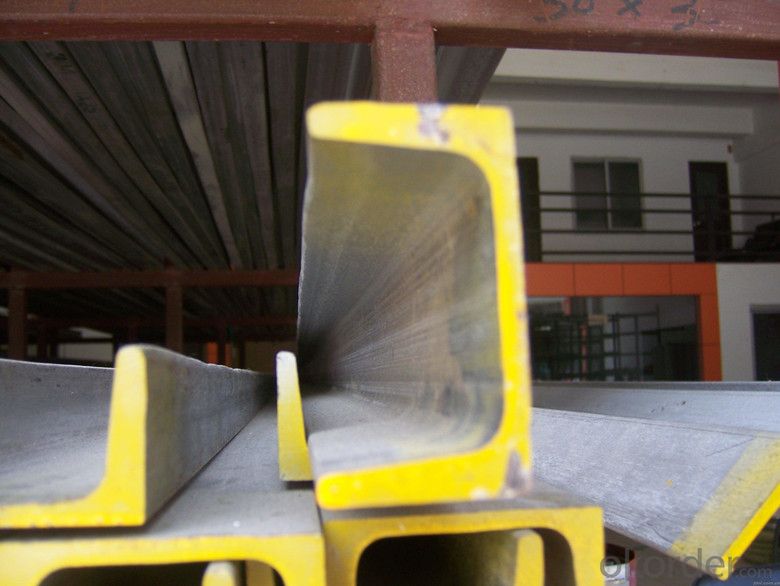
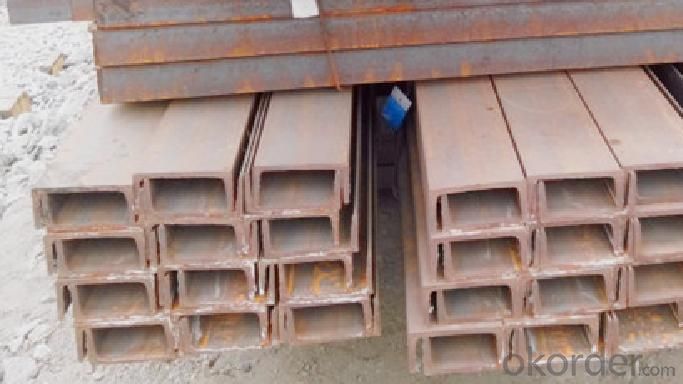
- Q: Are steel channels suitable for use in industrial shelving?
- Indeed, steel channels prove to be generally fitting for utilization in industrial shelving. With their durability, strength, and load-bearing capacity, steel channels present an ideal option for heavy-duty applications within industrial environments. They possess the ability to withstand substantial loads while offering stable support for an array of products and materials. Moreover, steel channels exhibit resistance against corrosion, a vital characteristic in settings with high humidity or exposure to chemicals. Their versatility permits convenient customization and adjustment of shelf heights, guaranteeing efficient storage solutions. In summary, steel channels emerge as a dependable selection for industrial shelving, offering enduring and sturdy storage solutions.
- Q: Can steel channels be used in the aerospace parts manufacturing industry?
- Indeed, the aerospace parts manufacturing industry can employ steel channels. The construction of aircraft structures and components often relies on steel channels, owing to their remarkable attributes of strength, durability, and resistance to deformation. Framing, support structures, and reinforcement for crucial aerospace parts are among the diverse applications that steel channels can fulfill. By providing structural integrity and stability, steel channels play a pivotal role in ensuring the secure and dependable operation of aerospace vehicles. Moreover, the aerospace industry benefits from the ease of fabrication and welding that steel channels offer, rendering them an excellent choice that upholds precision and quality, which are paramount in this field.
- Q: Can steel channels be painted?
- Yes, steel channels can be painted. Painting steel channels can provide a protective coating that prevents corrosion and enhances their aesthetic appeal. However, there are a few important considerations to keep in mind when painting steel channels. Firstly, the surface of the channels should be clean and free from any dirt, grease, or rust. It is recommended to use a wire brush or sandpaper to remove any loose particles and create a smooth surface for the paint to adhere to. Additionally, it is crucial to use a primer specifically designed for metal surfaces to ensure proper adhesion and durability of the paint. Once the primer has been applied and dried, a suitable paint can be used to coat the steel channels. It is important to choose a paint that is compatible with metal surfaces and provides resistance to corrosion and weathering. Applying multiple coats of paint may be necessary to achieve the desired finish and durability. Overall, with proper surface preparation and the use of suitable primers and paints, steel channels can be effectively painted to protect them and enhance their appearance.
- Q: How are steel channels used in the manufacturing of machinery?
- Steel channels are commonly used in the manufacturing of machinery due to their structural strength and versatility. These channels, also known as C-channels or U-channels, are typically made from hot-rolled steel and have a distinct shape resembling the letter "C" or "U". In the manufacturing process, steel channels are used for various purposes. They can be used as structural components to provide support and stability to the machinery. The channels are often used as frames or bases for equipment, providing a solid foundation for the other components to be attached to. Additionally, steel channels can be used as guides or tracks for moving parts within the machinery. By attaching rollers or bearings to the channels, machinery components can easily slide or roll along the track, enabling smooth and precise movements. Steel channels are also used as reinforcement for machinery components. They can be welded or bolted onto parts that require additional strength or rigidity. This reinforcement helps to prevent bending, warping, or distortion of the machinery during operation, ensuring its durability and longevity. Furthermore, steel channels can be used for mounting various accessories or attachments. By attaching brackets, clamps, or other components to the channels, machinery designers can easily customize and configure the equipment to meet specific requirements. Overall, steel channels play a crucial role in the manufacturing of machinery by providing structural support, guiding moving parts, reinforcing components, and facilitating customization. Their strength, versatility, and ease of use make them an ideal choice in the construction of robust and reliable machinery.
- Q: Do steel channels have any specific vibration damping properties?
- Steel channels do have some inherent vibration damping properties, although they may not be as effective as other materials specifically designed for vibration damping. Steel channels, due to their solid and rigid structure, can help absorb and dissipate vibration energy to some extent. This is because steel has a relatively high density, which allows it to absorb and distribute vibration energy more effectively than lighter materials. Additionally, the shape and geometry of steel channels can also contribute to their vibration damping properties. The design of the channel, such as its cross-sectional shape and dimensions, can affect its ability to dampen vibrations. However, it is important to note that steel channels may not be as efficient in vibration damping as materials specifically engineered for this purpose, such as elastomers or composite materials. These materials often have properties that are specifically tailored to dissipate vibrations, offering superior damping characteristics compared to steel channels. Therefore, while steel channels do possess some inherent vibration damping properties, they may not be the most effective choice for applications where significant vibration damping is required.
- Q: What are the different loadings that steel channels can withstand?
- Steel channels can withstand a wide range of loadings, making them a versatile and reliable structural component. The specific loadings that steel channels can withstand depend on various factors, including the type and grade of steel, the size and shape of the channel, and the design of the overall structure. Steel channels are commonly used in construction and engineering applications to provide support and stability. They can withstand both static and dynamic loadings, which include dead loads, live loads, and environmental loads. Dead loads refer to the weight of the structure itself, including the weight of the steel channels and any other components or materials. Steel channels are designed to bear this constant load without deformation or failure. Live loads are temporary loads that can vary in magnitude and location. These loads include the weight of people, furniture, equipment, and other transient forces. Steel channels are designed to support these loads and distribute them effectively to other structural members. Environmental loads include wind loads, snow loads, and seismic loads. Steel channels are designed to resist these external forces and maintain the structural integrity of the building or structure. Wind loads can exert significant pressure on the channels, especially on tall or exposed structures. Snow loads can accumulate and add weight to the structure, which the steel channels must be able to support. Seismic loads refer to the forces generated during an earthquake, and steel channels are designed to withstand these dynamic loads and prevent the structure from collapsing. In addition to these common loadings, steel channels can also withstand other specialized loadings, such as impact loads, vibration loads, and thermal loads. Impact loads can occur due to accidental collisions or sudden impact events and require steel channels to have high strength and toughness. Vibration loads can result from machinery or equipment operation and require steel channels to have good fatigue resistance. Thermal loads can cause expansion and contraction of the steel channels due to temperature changes, and they must be designed accordingly to prevent failure. Overall, steel channels have a high load-bearing capacity and can withstand a wide range of loadings, making them suitable for various structural applications in construction, engineering, and industrial sectors.
- Q: Are steel channels suitable for temporary structures?
- Yes, steel channels can be suitable for temporary structures. Steel channels are commonly used in construction for their strength and durability. They are versatile and can be easily fabricated and assembled to create temporary structures such as scaffolding, shoring, and temporary supports. Steel channels provide stability and load-bearing capacity, making them ideal for supporting temporary structures during construction or event setups. Additionally, steel channels are resistant to weathering and can withstand heavy loads, ensuring the safety and stability of the temporary structure.
- Q: How are steel channels protected against rusting and corrosion?
- Steel channels are protected against rusting and corrosion through various methods such as coating them with corrosion-resistant materials like zinc or paint, galvanizing them by applying a layer of zinc through a hot-dip process, or using stainless steel channels which have inherent resistance to rusting and corrosion.
- Q: How big is the channel used for the 4 metre span?
- The specifications are expressed by the height of the waist (H) * leg width (b) * waist thickness (d), such as "work 160*88*6", which means that the waist height is 160 mm, the width of the leg is 88 mm, and the thickness of the waist is 6 mm. The specifications of I-beam can also be expressed by type. The model indicates the height of centimeters, such as 16#.
- Q: How are steel channels measured and specified?
- Steel channels are measured and specified based on their dimensions and properties. The measurement of steel channels includes their height, width, and thickness. The height of a channel is usually measured as the vertical distance between the top and bottom flanges. The width refers to the horizontal distance between the flanges. The thickness, also known as the gauge, is the distance between the inner surfaces of the flanges. It determines the strength and load-bearing capacity of the channel. The thickness is usually measured in millimeters or inches. In addition to these basic measurements, steel channels are also specified based on their weight per unit length. This weight is commonly expressed in pounds per foot or kilograms per meter. It is essential for calculating the total weight of the channel required in a construction project. Steel channels may also have specific designations or grades based on their composition and properties. For instance, some channels may be designated as "C" channels, while others may be classified as "MC" or "S" channels. These designations indicate the shape and structural properties of the channel. Specifying steel channels involves providing detailed information about the desired dimensions, thickness, weight, and any specific grade or designation required. This information helps in accurately procuring and utilizing the appropriate steel channels for a construction or engineering project.
Send your message to us
Hot Rolled Channel Steel AISI,ASTM,BS,DIN,GB,JIS Standard
- Loading Port:
- Tianjin
- Payment Terms:
- TT OR LC
- Min Order Qty:
- 2000 PCS
- Supply Capability:
- 40000 PCS/month
OKorder Service Pledge
OKorder Financial Service
Similar products
Hot products
Hot Searches
Related keywords
